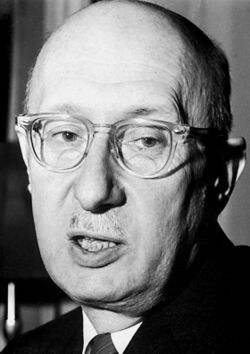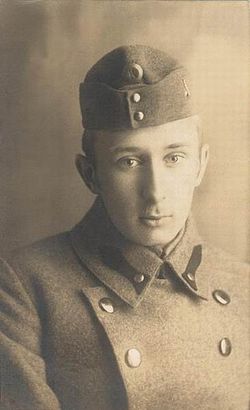Biography:Georg von Békésy
Georg von Békésy | |
|---|---|
 Békésy in 1961 | |
| Born | György Békésy 3 June 1899 |
| Died | 13 June 1972 (aged 73) Honolulu, Hawaii, U.S. |
| Citizenship |
|
| Education | University of Bern |
| Known for | Cochlea |
| Awards | Nobel Prize in Physiology or Medicine (1961) ASA Gold Medal (1961) |
| Scientific career | |
| Fields | Biophysics |
Georg von Békésy (Hungarian: Békésy György, pronounced [ˈbeːkeːʃi ˈɟørɟ]; 3 June 1899 – 13 June 1972) was a Hungarian-American biophysicist.[1]
By using strobe photography and silver flakes as a marker, he was able to observe that the basilar membrane moves like a surface wave when stimulated by sound. Because of the structure of the cochlea and the basilar membrane, different frequencies of sound cause the maximum amplitudes of the waves to occur at different places on the basilar membrane along the coil of the cochlea.[2] High frequencies cause more vibration at the base of the cochlea while low frequencies create more vibration at the apex.[3]
He concluded that his observations showed how different sound wave frequencies are locally dispersed before exciting different nerve fibers that lead from the cochlea to the brain.
In 1961, he was awarded the Nobel Prize in Physiology or Medicine for his research on the function of the cochlea in the mammalian hearing organ.[4]
Biography
Békésy was born on 3 June 1899 in Budapest, Hungary, as the first of three children (György 1899, Lola 1901 and Miklós 1903) to Sándor Békésy (1860–1923), an economic diplomat, and to his mother Paula Mazaly.
The Békésy family was originally Reformed but converted to Catholicism.[5] His mother, Paula Mazaly (1877–1974) was born in Szagolyca (now Čađavica, Croatia). His maternal grandfather was from Pécs.[6] His father was born in Kolozsvár (now Cluj-Napoca, Romania).
Békésy went to school in Budapest, Munich, and Zürich. He studied chemistry in Bern and received his PhD in physics on the subject: "Fast way of determining molecular weight" from the University of Budapest in 1926.
He then spent one year working in an engineering firm. He published his first paper on the pattern of vibrations of the inner ear in 1928. He was offered a position at Uppsala University by Róbert Bárány, which he declined because of the hard Swedish winters.
Before and during World War II, Békésy worked for the Hungarian Post Office (1923 to 1946), where he did research on telecommunications signal quality. This research led him to become interested in the workings of the ear. In 1946, he left Hungary to follow this line of research at the Karolinska Institute in Sweden.
In 1947, he moved to the United States , working at Harvard University until 1966. In 1962 he was elected a Member of the German Academy of Sciences Leopoldina.[7] After his lab was destroyed by fire in 1965, he was invited to lead a research laboratory of sense organs in Honolulu, Hawaii. He became a professor at the University of Hawaii in 1966 and died in Honolulu.
He became a well-known expert in Asian art. He had a large collection which he donated to the Nobel Foundation in Sweden. His brother, Dr. Miklós Békésy (1903-1980), stayed in Hungary and became a famous agrobiologist who was awarded the Kossuth Prize.
Research
Békésy contributed most notably to our understanding of the mechanism by which sound frequencies are registered in the inner ear. He developed a method for dissecting the inner ear of human cadavers while leaving the cochlea partly intact. By using strobe photography and silver flakes as a marker, he was able to observe that the basilar membrane moves like a surface wave when stimulated by sound. Because of the structure of the cochlea and the basilar membrane, different frequencies of sound cause the maximum amplitudes of the waves to occur at different places on the basilar membrane along the coil of the cochlea.[2] High frequencies cause more vibration at the base of the cochlea while low frequencies create more vibration at the apex.[3]
Békésy concluded from these observations that by exciting different locations on the basilar membrane different sound wave frequencies excite different nerve fibers that lead from the cochlea to the brain. He theorized that, due to its placement along the cochlea, each sensory cell (hair cell) responds maximally to a specific frequency of sound (the so-called tonotopy). Békésy later developed a mechanical model of the cochlea, which confirmed the concept of frequency dispersion by the basilar membrane in the mammalian cochlea.[2]
In an article published posthumously in 1974, Békésy reviewed progress in the field, remarking "In time, I came to the conclusion that the dehydrated cats and the application of Fourier analysis to hearing problems became more and more a handicap for research in hearing,"[8] referring to the difficulties in getting animal preparations to behave as when alive, and the misleading common interpretations of Fourier analysis in hearing research.
Awards
Békésy's honours include:
- The Denker Prize in Otology (1931), The Leibniz Medal of the Berlin Academy of Sciences (1937), The Guyot Prize for Speech and Otology of Groningen University (1939), The Academy Award of the Budapest Academy of Science (1946), Shambough Prize in Otology (1950).
- Honorary doctorates (M.D.) were conferred on him by the University of Munster (1955), Bern (1959), Padua (1962), Buenos Aires (1968), Cordoba (1968), Hawaii (1969) and Semmelweiss University, Budapest (1969).
References
- ↑ "NobelPrize, "Georg von Békésy Biographical"". https://www.nobelprize.org/prizes/medicine/1961/bekesy/biographical/.
- ↑ 2.0 2.1 2.2 Goldstein, B. 2001. Sensation and Perception, 6th ed. London: Wadsworth.
- ↑ 3.0 3.1 Lera Boroditsky. (1999) "Hearing I: Lecture Notes." pp. 3
- ↑ Stevens, S. S. (September 1972). "Georg von Békésy". Physics Today 25 (9): 78–80. doi:10.1063/1.3071029. Bibcode: 1972PhT....25i..78S. http://www.physicstoday.org/resource/1/phtoad/v25/i9/p78_s1?bypassSSO=1.
- ↑ "Békésy György". http://www.nevpont.hu/view/1052.
- ↑ "Békésy György emléktáblája". https://www.kozterkep.hu/~/29911/Bekesy_Gyorgy_emlektablaja_Pecs_2011.html.
- ↑ "List of Members". http://www.leopoldina.org/en/members/list-of-members/member/1871/.
- ↑ Georg von Békésy (1974), "Some Biophysical Experiments from Fifty Years Ago", Annual Review of Physiology 36: 1–16, doi:10.1146/annurev.ph.36.030174.000245, ISBN 978-0-8243-0336-5, PMID 19143520, https://books.google.com/books?id=jCkJAAAAIAAJ
Further reading
- Czeizel, Andrew E. (2004), "Famous Hungarian physicians", Lancet 364 (9434): 581–2, doi:10.1016/S0140-6736(04)16847-5, PMID 15313356
- Evans, Rand B. (2003), "Georg von Békésy: visualization of hearing", The American Psychologist 58 (9): 742–6, Sep 2003, doi:10.1037/0003-066X.58.9.742, PMID 14584991
- Raju, T. N. (1999), "The Nobel chronicles. 1961: Georg von Békésy (1899–1972)", Lancet 354 (9172): 80, Jul 3, 1999, doi:10.1016/S0140-6736(05)75353-8, PMID 10406402
- Shampo, M. A.; Kyle, R A (1993), "Georg von Békésy—audiology and the cochlea", Mayo Clin. Proc. 68 (7): 706, Jul 1993, doi:10.1016/s0025-6196(12)60608-9, PMID 8350644
- Tonndorf, J. (1986), "Georg von Békésy and his work", Hear. Res. 22 (1–3): 3–10, doi:10.1016/0378-5955(86)90067-5, PMID 3525485
- Bernhard, C. G. (1986), "Georg von Békésy and the Karolinska Institute", Hear. Res. 22 (1–3): 13–7, doi:10.1016/0378-5955(86)90069-9, PMID 3525483
- "Proceedings of Nobel Symposium 63. Cellular mechanisms in hearing (en hommage à Georg von Békésy). Karlskoga, 2–6 September 1985", Hear. Res. 22: 1–326, 1986, PMID 3525481
- Tonndorf, J. (1974), "In memoriam Georg von Békésy 1899–1972", J. Acoust. Soc. Am. 55 (3): 576–7, Mar 1974, doi:10.1121/1.1914566, PMID 4594785, Bibcode: 1974ASAJ...55..576T
- Glorig, A. (1973), "Georg von Békésy 1899–1972", Audiology 12 (5): 540–1, doi:10.3109/00206097309071667, PMID 4582926
- Keidel, W. D. (1973), "In memorian Professor Dr. phil. Dr. med. h.c. Georg v. Békésy", Kybernetik 12 (2): 116–8, Feb 1973, doi:10.1007/BF00272468, PMID 4571620
- Ratliff, F. (1973), "Georg von Békésy", Experimental Brain Research. Experimentelle Hirnforschung. Expérimentation Cérébrale 16 (3): 219–20, Jan 29, 1973, doi:10.1007/BF00233326, PMID 4568685
- Keidel, W. D. (1973), "[In memoriam Professor Dr.phil.Dr.med.h.c. Georg von Békésy]", Zeitschrift für Laryngologie, Rhinologie, Otologie und ihre Grenzgebiete 52 (1): 1–6, Jan 1973, PMID 4567951
- Davis, H. (1972), "Georg von Békésy, 1899–1972", Ann. Otol. Rhinol. Laryngol. 81 (5): 750–1, Oct 1972, doi:10.1177/000348947208100518, PMID 4568444
- Zwislocki, J. J. (1972), "Georg von Békésy, 1899–1972", J. Acoust. Soc. Am. 52 (4): 1094–5, Oct 1972, PMID 4563147
- "Georg von Beksey", ASHA 14 (9): 513, Sep 1972, ISSN 0001-2475, PMID 4560564
- Tonndorf, J. (1972), "[Obituary for Georg von Békésy (1899–1972)]", Archiv für klinische und experimentelle Ohren- Nasen- und Kehlkopfheilkunde 203 (1): 81–5, doi:10.1007/BF00344566, PMID 4564741
- "The American Speech and Hearing Association presents the honors of the Association", ASHA 9 (6): 222, 1967, Jun 1967, PMID 5343023
- Bernhard, C. G. (1962), "Presentation of the Nobel prize for physiology or medicine (1961) to George von BEKESY", Transactions of the American Otological Society 50: 332–6, PMID 13971073
- Keidel, W. D. (1961), "[G. von BEKESY Nobel prize winner 1961.]", Zeitschrift für Laryngologie, Rhinologie, Otologie und ihre Grenzgebiete 40: 885–8, Dec 1961, PMID 14037041
- Palva, T. (1961), "[The 1961 Nobel prize in medical science and physiology (Georg von BEKESY).]", Duodecim; Lääketieteellinen Aikakauskirja 77: 791–2, PMID 14037251
External links
- Miss nobel-id as parameter including the Nobel Lecture, December 11, 1961 Concerning the Pleasures of Observing, and the Mechanics of the Inner Ear
- Georg von Békésy page at the Pacific Biosciences Research Center
- Békésy Laboratory of Neurobiology website
- Békésy art collection
- My experiences in different laboratories, autobiographical speech by von Békésy
- The Ear Pages game
 |


